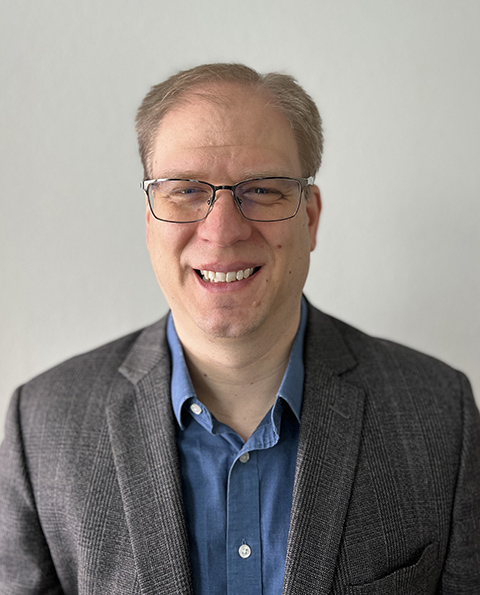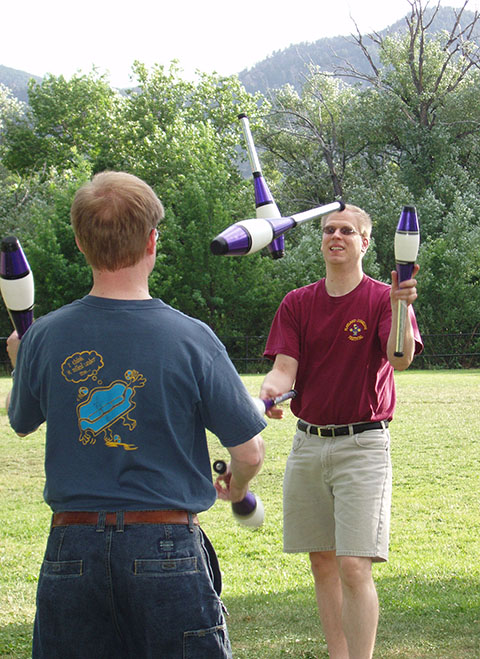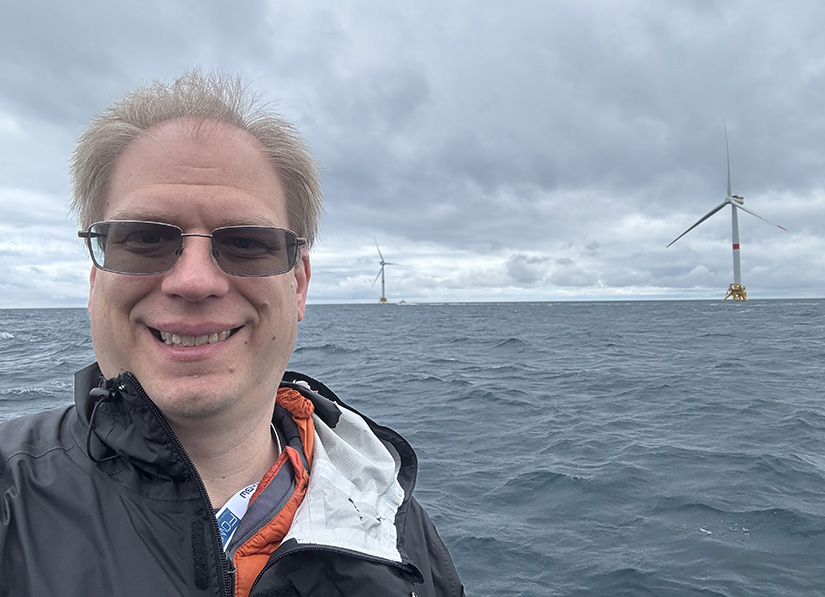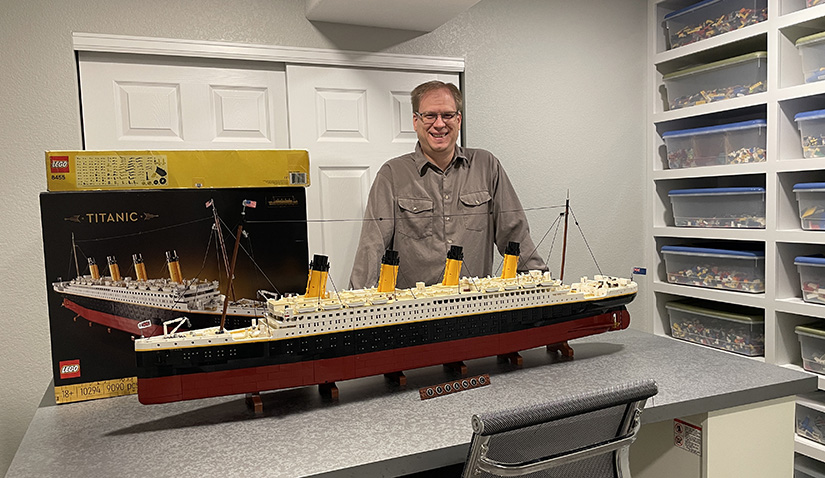Juggling Motion: Jason Jonkman's Exploration of Movement Helped Him Become a Floating Wind Energy Expert
He Is Among the Latest Cohort of NREL’s Distinguished Researchers
When Jason Jonkman was an undergraduate at a northwest Iowa college, he tried juggling outdoors with standard plastic clubs.
Although he was an experienced juggler, the gusts on the plains thwarted his skills by buffeting the 20-inch objects and disrupting his tossing patterns. Such clubs may look like fluorescent 3.5-pound bowling pins but actually weigh much less.

Jason Jonkman. Photo from Jason Jonkman, NREL
“It was difficult to juggle outside in the Iowa winds,” Jonkman admitted.
That challenge did not kill his love for the tricky art—and actually helped fan his passion for wind energy.
Juggling remains one of two personal hobbies in his life carried over from youth. (The other is building models with Lego bricks.) The principal researcher still practices juggling various objects: He can keep six balls or five clubs aloft at once. Since college, he has has been working to add a seventh ball in the air, the “perfect number,” he believes, for juggling balls. After 20-plus years of effort, he says “progress has been asymptotic” (ever closer, but never quite there).
Along the way, he has accomplished many feats. In more controlled (and less windy) settings, Jonkman even tossed knives and flung flaming torches in college. However, he dismissed those props as gimmicks. “Once you know how to juggle clubs, the knives and torches are basically the same,” he said. In fact, his only juggling-related injuries came from not stretching properly beforehand as he has aged. He loves what drew him to the practice in high school: an appreciation of the underlying math as well as the focus required to juggle well. Today, Jonkman enjoys passing clubs with others and can be found at a yearly convention of jugglers in Boulder.
But the Midwestern winds surely made a lasting impression.
Even though his engineering professors at Dordt College (now Dordt University) embraced solar power and other renewables, wind energy piqued Jason’s curiosity despite wreaking havoc with his airborne clubs. The faith-based school emphasized that a student’s worldview should reflect what you do in life—and so, renewable energy was an important part of respecting the planet. As a result, Jonkman, having grown up in Seattle around the aerospace industry and expecting to design airplanes when he grew up, drew upon his background and interest in fluids, structures, and controls to try to harness the wind.
For his senior thesis, he borrowed a vertical-axis turbine, built a numerical model predicting the turbine’s operation, and took turbine measurements in those same windswept fields. He also talked about the machine with Paul Veers, then a wind expert at Sandia National Laboratories. It was an early attempt to understand wind power. “Looking back, the experiment and model were flawed, but it gave me that passion for wind energy,” Jonkman said.
Yet juggling was never far from mind. At one point, while trying to teach himself programming, Jonkman wrote a juggling animation program. “You type in what you want to juggle, and then it animates that. In addition to programming, I learned a lot of the physics behind juggling, as well as the math behind juggling patterns,” he said.

Jason Jonkman juggles or “passes” six clubs with another juggler—one of his enduring passions. Photo from Jason Jonkman, NREL
Interning in college and after graduation, he did a stint at Boeing but felt a pull—or maybe a kite-like tug—back to wind energy. Eventually, he enrolled at Colorado State University to pursue a master’s degree in mechanical engineering with the hopes of getting into the wind energy field.
While there, he reached out to one of the National Renewable Energy Laboratory’s (NREL's) wind pioneers, Sandy Butterfield. Over time, Butterfield and others gave Jonkman a chance to begin validating the laboratory’s predictive wind energy computer model, FAST, against experimental data.
“I wanted to find out how it worked,” he said. At the time, Jonkman found a lot of issues with the original code. Once he finished his degree, NREL’s wind team asked him to stick around to fix the issues that he uncovered. His career took off with an internship at NREL in 2001, soon after which he started earning a Ph.D. in aerospace engineering sciences from the University of Colorado Boulder.
In a sense, the jet stream of wind energy fascination helped carry him to his current position—and allowed him to become one of NREL’s 2024 Distinguished Researchers.
Catching the NREL Jetstream
Juggling, whether objects or numbers, has remained a constant.
“I lead our team that develops our engineering fidelity software for wind energy applications: OpenFAST and FAST.Farm,” he said. OpenFAST is an open-source wind turbine simulation tool that was established from early predecessors of the FAST code as its starting point. FAST.Farm extends OpenFAST for a single turbine to full wind farm dynamics.
Jonkman soon sought mastery. “It’s a big team here, so I share credit with many. But I did a lot of the original core work,” he said.
Sharpening FAST is one of two things Jonkman is known for. The other, which is linked, is advancing the potential of offshore wind. Jonkman actively supports the development of the international design standard for floating wind (IEC 61400-3-2) as well as multiple International Energy Agency Wind model verification and validation collaboratives.
Jonkman said he was fortunate to be at NREL as Butterfield and Walt Musial began to express their vision for offshore floating wind turbines around 2000. “They knew they needed someone like me to kind dig into details about how to do design and model such systems,” he said. Because of his original work with FAST, Jonkman said he was able to focus on floating wind for his Ph.D. thesis, which was published in 2007.
“They helped me form my original ideas. And then I got into the details about how you actually make this happen,” he said.
In a way, Jonkman keeps multiple balls, or ideas, in the air. As Musial wrote while nominating Jonkman for the 2022 Viterna Award for engineering excellence awarded by the Business Network for Offshore Wind (now Oceantic), Jonkman spent many years “upgrading the clunky land-based wind turbine dynamics code” to apply to floating turbines.

Jason Jonkman visited three offshore turbines in the Mediterranean Sea earlier in 2024. Photo by Jason Jonkman, NREL
For example, by 2005, as Musial noted, the FAST tool “could simulate wind turbines with wave actions, anchor system dynamics, and coupled floating platform dynamics and integrated the advanced controls needed to stabilize the complex system motion.” Familiar with motion, it was a natural fit for Jonkman to analyze turbines atop floating platforms that can be “excited by” waves, currents, atmosphere—under far different conditions that impact fixed-bottom turbines.
“I was one of the first ones to get into that field of floating wind. When I started, I was a little nervous to be honest. The industry was not really talking much about floating wind,” he said, expecting to be known as “one of these weird guys” looking at this field. Some skeptics scoffed, saying floating wind turbines would never become a reality.
Fortunately, another company was following the lead and had a similar vision for floating wind. In 2009, the Norwegian state-owned energy company Statoil (now Equinor) built a floating demonstration turbine, Hywind, in a depth of 220 meters off the coast of Norway. Naturally, Jason engaged with them. “I said please don’t let this demonstration fail—because that would kill the industry forever, or a very long time.” Fortunately, Hywind did not fail, and the offshore industry picked up momentum from there.
There have been many milestones marking this progress. With over 200 publications, Jonkman is the most-cited wind researcher at NREL, in the top five in wind energy globally, and in the top 20 overall in citations at NREL. Many of his papers and presentations note the complexity of the problems facing developers: “The coupled nonlinear interaction between aerodynamic, hydrodynamic, and structural forces with the turbine control makes design of floating wind platforms challenging.”
FAST helped provide answers to such challenges, and for a time, FAST became the workhorse tool for the offshore wind industry, he said.
While there is now competition in the marketplace from other computer-based turbine design tools, Jonkman said NREL still plays a big role. “We definitely pushed the original development and continue to push developments in new directions,” he said.
Now an internationally recognized expert in engineering modeling and design of wind turbines, wind farms, and offshore floating structures, Jonkman was key in cementing NREL’s reputation as a wind powerhouse. His colleague Amy Robertson said, “Jason’s expertise has brought international recognition as a leader in both land-based and offshore wind applications. Without Jason, our research program would be a shadow of its present self.”
His work has gone from theory to real-world impact. Jonkman is thankful to have seen the theoretical possibilities blossom into reality. Recently, he was invited to see a floating turbine off the northern coast of Spain developed in part with OpenFAST. Around that time, he was at a conference in France and saw three more installed floating turbine structures in the Mediterranean Sea.
Jonkman, whose college emphasized finding a meaningful path in life, is modest. “I was lucky with my timing, being in the right place at the right time,” he said. “It’s exciting to see the industry develop now. We’re at a precommercial state in floating wind and well along the path to full commercialization.”
Things will evolve, he knows. “There are quite a few good floating wind ideas out there—but I don’t think they’re all going to be industrially successful,” he said. “The need is obviously there for clean, renewable energy near where the population is.”
Like the increasingly accomplished juggler he aspires to be, Jonkman is not content to rest at his current level. He is exploring new areas, such as the development of offshore turbine “digital twins.” These configurations use the design tools to run in parallel to real-world assets, acting as virtual sensors to allow more efficient operation of actual floating turbines. By incorporating measurements from the loads the turbines experience, operators can improve maintenance and design better next-generation turbines.
In the future, he intends to continue to improve tools that can be used by industry partners to design and operate better wind turbines and wind farms. Jonkman said that he asks himself this question often: How can NREL be the best support to make the wind industry move ahead?
Wind is also a topic at home. Jonkman, who met his wife, Bonnie, at Dordt, has plenty to discuss over their dinner table in Erie, Colorado—because she also works at a Boulder wind energy firm she joined after working at NREL for a time. They enjoy parenting a teenage daughter—although as she gets older, it means adjusting. “I have to find my new role as a dad,” he laughed.

Another enduring hobby is constructing with Lego blocks in his dedicated Lego room. Photo from Jason Jonkman, NREL
Family remains a top priority, even though Jonkman can no longer count on building Lego sets with his daughter, who has found other activities. Still, that will not keep him from enjoying his dedicated Lego room himself, where he spends time weekly relaxing by constructing things such as a functional foosball table. And traveling and hiking are activities their family continues to enjoy doing together.
While he does not have the five or six hours needed to fully perfect the most advanced levels of juggling that professional acts do, he does still spend time with his go-to props, juggling balls and juggling clubs. It is in his blood.
There are other constants too in his life. Just as the wind across the Iowa plains persisted—and helped a Seattle native appreciate its energy potential, so too does Jonkman’s desire to keep pushing ahead steadily with ways to interact with wind. He will keep juggling with the dynamic forces of energy in motion that drive offshore wind energy. From the looks of it, he is getting pretty good.
Last Updated May 28, 2025
